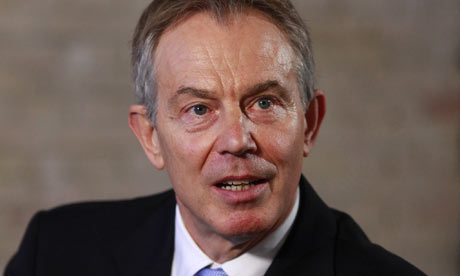Mystery of Tony Blair's money solved
The winner of the Guardian's online contest to solve the mystery of Blair's finances is Richard Murphy, a crusading accountant from Tax Research UK. His entry unearthed the small print of the Partnership (Accounts) Regulations 2008 to reveal that Blair has found an unusual method to keep his wealth secret from the rest of us. Murphy wins an original cartoon by Steve Bell.
- guardian.co.uk, Thursday 17 December 2009 15.00 GMT
- Article history

Tony Blair, in effect, has the benefits of running a British company without the drawbacks of unwelcome publicity. Photograph: Bob Strong/Reuters
A little-known loophole in UK company law is being used by Tony Blair to keep his finances secret, the Guardian can disclose.
Blair would normally have to publish company accounts detailing the millions flowing into his various commercial ventures since he stepped down from office in 2007.
But he has set up a complicated artificial structure which avoids the normal rule. In effect, he is getting the benefits of running a British company without the drawbacks of unwelcome publicity.
His main vehicle is a so-called limited partnership, christened Windrush Ventures No 3 LP.
Thanks to a gap in the Whitehall regulations, this entity is not required to publish any accounts. Such partnerships must normally disclose figures, or face criminal penalties.
Blair sidestepped the rules by inserting a second partnership as one of the notional partners, in a way the regulations do not cover.
This second partnership, Windrush Ventures No 2 LLP, is a so-called limited liability partnership, a type of entity only invented in 2000, which the rules have not been updated to mention.
The LLP in turn controls Blair's operating company, called Windrush Ventures Ltd, which runs his Mayfair office in Grosvenor Square.
The perfectly legal structures Blair has set up to achieve secrecy are so complicated that they have previously baffled analysts.
They involve 12 different entities, six in the Windrush structure and another half-dozen in a more recent parallel structure called Firerush.
Blair's spokesman told us: "This has been done on the basis of legal and accountancy advice throughout." He called the structures "simply an administrative vehicle established in order to allow Mr Blair's office sensibly to administer his different projects".
One name involved is Blair's lawyer Alexandra Harle, of solicitors Bircham Dyson Bell. She specialises in setting up various types of partnership. Observers estimate that fees for keeping up such complex structures exceed £15,000 a year.
When Blair refused to give any information, the Guardian ran a worldwide online competition as an experiment in crowd-sourcing, to find the best explanation for his schemes.
The winner was crusading accountant Richard Murphy, of Tax Research UK. He identified the small print of the Partnership (Accounts) Regulations 2008 as the key to the mystery.
"Memo to Peter Mandelson: this really is an abuse you should stop very soon," he says.
Murphy adds: "What is it that Tony is so keen to hide that he'll go to this length and this cost to do so?"
While the law requires Blair to publish limited accounts for parts of the Windrush entities, the finances of the master-partnership remain a secret. More than £6m can be seen to have cascaded down from the partnership into other companies. But details of the full revenues remain hidden.
Murphy claims this gives Blair all the advantages of an offshore "secrecy jurisdiction" while allowing him to state, correctly, that he remains a regular, onshore, British taxpayer.
There were a large number of other entries to the Guardian competition – rapidly dubbed the Blair Rich Project.
Some responses set out to be witty. Zap Papa, an otherwise anonymous artist, said the name Windrush must be reminiscent of the asinine Ian Carmichael character Stanley Windrush in the 1959 film comedy I'm All Right Jack.
"The film had a general theme of intolerance towards trade union activity – quite apposite in regard to the pompous target of your investigation," Zap Papa said.
Iain Miller said the answer to the question "Who is Blair's partner?" must be: "He's in partnership with God."
Others merely took advantage of anonymity to be rude about our former prime minister.
But more dedicated, and sometimes far-flung online readers spotted unexpected facts in the small print of the posted documents.
From China, a computer programmer, Joe Gittings, unearthed Blair's brief flirtation with the law firm Rosenblatts before he moved on to Bircham Dyson Bell. Rosenblatt's address was listed on early Companies House filings.
Jonathan Metliss, a Rosenblatt lawyer at the time, was a friend of Cherie Blair's confidante Martha Greene.
Another novel fact unearthed by an anonymous online researcher was that Windrush registered a domain name for the Low Carbon Capital Fund. This is a hitherto unknown project of Blair's, yet to achieve lift-off.
Other accountants and tax advisers speculated that Blair might have been contemplating going offshore were he to become EU president.
One particularly cynical entrant suggested that Blair might have been relieved of large fees by crafty financial advisers, in return for an unnecessarily complex structure.
http://www.guardian.co.uk/politics/2009/dec/17/mystery-tony-blairs-money-solved
Tony Blair Admits He Would Have Invaded Iraq Anyway

No comments:
Post a Comment